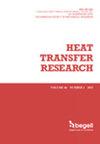在带磁涡流发生器的热交换器中循环的铁流体的热量和流体流动特性
IF 1.6
4区 工程技术
Q3 THERMODYNAMICS
引用次数: 0
摘要
目前的研究旨在对流经热交换器的〖铁〗_3 O_4/水纳米流体的熵产生和热效率进行数值研究和分析,其中考虑到了多个相同的磁源。模拟域对应于一个以恒定温度从下往上加热的微型通道,而其上壁是绝热的。数值模拟采用有限体积法(VFM)进行。为确定磁性纳米流体的新热物理性质,采用了单相法。获得的结果显示为努塞尔特数、流线、等温线和产生的熵,以及其他相关参数,即磁场强度、磁铁对数量、雷诺数和纳米颗粒的体积分数。调查显示,这些参数对传热机制有重大影响。仔细选择这些参数对于提高熵的产生以及热传递的理想改善至关重要。本文章由计算机程序翻译,如有差异,请以英文原文为准。
Heat and fluid flow characteristics of ferrofluids circulating in a heat exchanger with a magnetic vortex generator
The current work aims numerically to investigate and analyze the entropy generation and thermal efficiency of 〖Fe〗_3 O_4/water nanofluids flowing through a heat exchanger considering multiple identical magnetic sources. The simulated domain corresponds to a minichannel heated from below at a constant temperature, while its upper wall is adiabatic. Numerical simulations were carried out using the finite volume method (VFM). To determine the new thermophysical properties of the magnetic nanofluid, the monophasic approach was adopted. The obtained results are presented as the Nusselt number, streamlines, isotherms and generated entropy with other relevant parameters, namely, the magnetic field strength, number of magnet pairs, number of Reynolds numbers and volumetric fraction of the nanoparticles. The investigation revealed that these parameters significantly influence the heat transfer mechanism. Selecting these parameters carefully is crucial for achieving enhanced generation of entropy and, consequently, desirable improvement in heat transfer
求助全文
通过发布文献求助,成功后即可免费获取论文全文。
去求助
来源期刊

Heat Transfer Research
工程技术-热力学
CiteScore
3.10
自引率
23.50%
发文量
102
审稿时长
13.2 months
期刊介绍:
Heat Transfer Research (ISSN1064-2285) presents archived theoretical, applied, and experimental papers selected globally. Selected papers from technical conference proceedings and academic laboratory reports are also published. Papers are selected and reviewed by a group of expert associate editors, guided by a distinguished advisory board, and represent the best of current work in the field. Heat Transfer Research is published under an exclusive license to Begell House, Inc., in full compliance with the International Copyright Convention. Subjects covered in Heat Transfer Research encompass the entire field of heat transfer and relevant areas of fluid dynamics, including conduction, convection and radiation, phase change phenomena including boiling and solidification, heat exchanger design and testing, heat transfer in nuclear reactors, mass transfer, geothermal heat recovery, multi-scale heat transfer, heat and mass transfer in alternative energy systems, and thermophysical properties of materials.
 求助内容:
求助内容: 应助结果提醒方式:
应助结果提醒方式:


